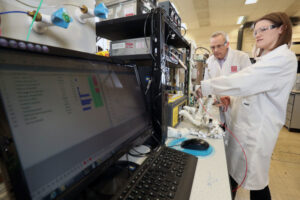Environmental Theme: Soot Control

The growth in market share of diesel vehicles, which currently stands at around fifty-five percent of new car sales within the EU, has had the beneficial effects of lowering CO2 emissions and improving fuel economy, but has led to locally high concentrations of NOx gases and carbon particulate in the atmosphere. Although plans are being put in place for phasing-out conventional diesel vehicles, the problems caused by NOx and particulate cannot be ignored in the intervening period of several decades.
The current technology for control of particulate matter (soot) emissions is a filter, which physically traps out the solid from the exhaust gases. However, these filters must be periodically regenerated by burning off the soot, which for passenger vehicles requires high temperatures (>600 °C) generated by fuel injection into the exhaust. An alternative solution would be to catalyse combustion of the soot at much lower temperatures, ideally within a normal exhaust-gas range of around 180 – 400 °C, preventing the build-up of soot and eliminating the fuel penalty associated with filter regeneration.
In a previous project at Cardiff University, a catalyst with good activity for soot oxidation by oxygen was developed, consisting of silver and potassium supported on a mixed metal oxide of ceria-zirconia-alumina. Work in the current project has continued using similar materials, with an aim of trying to understand the importance of each component which may lead to further catalyst development.
Based on our experimental results, we have proposed that for the potassium component of the catalyst, which is present in the form of potassium carbonate, the associated carbonate species may be of high importance for the activity; we have recently been awarded beam time at the XMaS synchrotron facility at ESRF in Grenoble to investigate this further, by monitoring the potassium speciation during reaction using XAFS.
Additionally, with our Hub project collaborators at Birmingham University, we have carried out catalyst testing by thermal gravimetric analysis (TGA) under real engine exhaust atmosphere rather than the air atmosphere used in our standard testing method; although there were some small differences, for example in reaction onset temperature, it was observed that results in air provide a good indication of the activity under exhaust gas.
There is also significant interest in simplifying the diesel vehicle exhaust clean-up system, which currently has numerous different catalysts, by combining soot combustion with NOx removal e.g. by selective catalytic reduction (SCR) with NH3.
By testing a range of catalysts for simultaneous NH3-SCR and soot oxidation, we have discovered that a supported silver catalyst, whilst not having the desired selectivity to N2 during SCR, was able to use the N2O generated at temperatures below 300°C to oxidise soot to CO2. We have since filed a patent application for diesel exhaust systems which would exploit this synergy between non-selective SCR and soot oxidation.
Author:
Catherine Davies, Cardiff University




